Origin and History of Lake Grapevine, 1919-1953, Part 6: Earth and People Start Moving
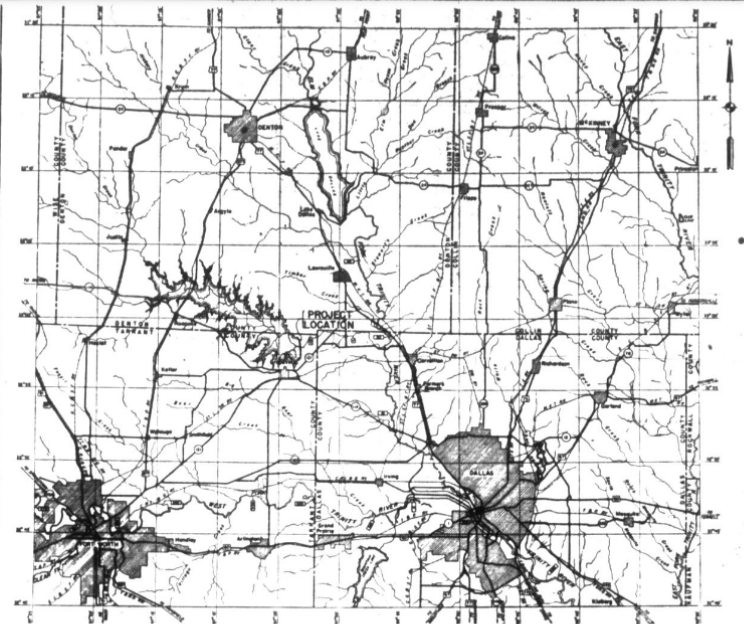
In the previous blog, we saw the preparations for the ground-breaking at the Grapevine Dam and Reservoir site on Denton Creek come together. Now that the ground had been broken, the effects of dam and reservoir construction slowly began to be felt among Grapevine’s approximately 1,800 residents. In this blog, we will see how a federal water and soil project impacted a small local population.
Former Grapevine Mayor B. R. Wall was not present at the ground-breaking festivities on December 5, 1947, but he noted the event in his diary: “Damsite ceremony and barbecue ,, Did not attend ,, Began work on Grapevine Dam on Denton Creek. Do not care to comment herein.” On December 8 he wrote “Worried about Dam,” but did not elaborate. On December 23 he met with Carl Simmons and one of his brothers at the “north area of the Lake view,” but did not give a reason. As displaced landowners, they may have had great concerns about where things were heading.
Actual construction on the dam began in January 1948, when contractor J. W. Mosley started a partial excavation of the 500-foot-long spillway and partial construction of the embankment. Condemnation proceedings had been filed in November and land appraisals and negotiations were underway.
The Machines Move In
On January 6, 1948, bulldozers, motor scrapers, draglines, tractors, and earth-moving Tournapulls began assembling for the first construction phase. Mosley leased a home on the R. W. Terrell farm south of Grapevine and would direct work on the contract. Mostly motorized equipment was used and fifteen men were employed. Operations started on January 22 on the north bank of Denton Creek after Mosley received a work order, but there was a delay of several weeks due to inclement weather. In February, he began clearing 127 acres of land and grubbing eighty acres. For excavation stripping, he began moving 59,200 cubic yards of earth.
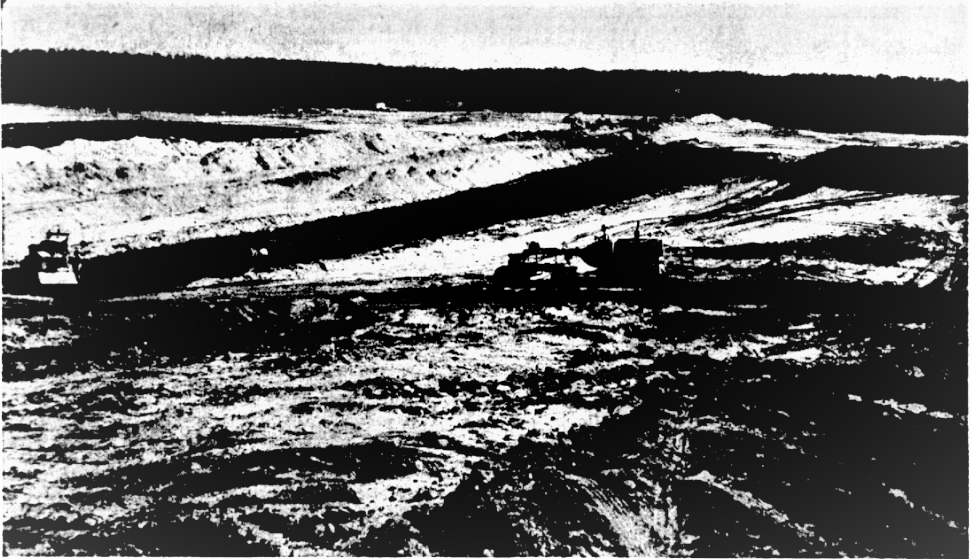
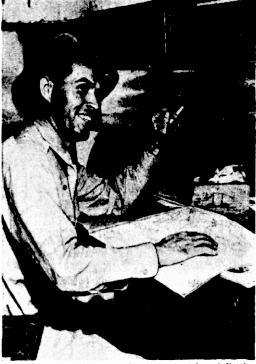
The major operation consisted of moving 3,392,000 cubic yards of soil from “borrow” excavation sites in the area and building an embankment fill of 3,169,000 cubic yards. Before Mosley could do that, he had to excavate 184,000 cubic yards of dirt for the embankment foundation, a common excavation of 513,200 cubic yards, and about 6,100 cubic yards of rock excavation. Congressman J. Frank Wilson of Dallas was initially pleased that President Truman’s 1948 budget included $4,300,000 for the continuation of work on the dam, but the House Appropriations Committee cut $1,000,000 for continuing construction on the project. Colonel Hutchings and John Fouts believed this would not seriously jeopardize it, but engineers recommended restoring the funds.
On February 2, the Grapevine City Council met to pass on an application made earlier by the Army Corps of Engineers (ACE) to tie a four-inch line to the city’s water main in order to furnish water to the construction site. After a lengthy discussion, the Council voted unanimously to reject it. No reason was given for the rejection. Later that month, the ACE praised the Tarrant County Clerk’s Office for the work their employees were doing tracing titles and deeds covering land in the Grapevine and Benbrook Dam areas.
To get an idea of what Mosley was dealing with, consider that one cubic yard of earth is a block three feet wide, three feet high, and three feet thick. Now multiply it 4,000,000 times. This was the size of a mountain of dirt being excavated, hauled, stacked, pulverized, and compacted at the dam site. Later, other contractors moved another 4,000,000 cubic yards of sandy clay and bottomland gravel. Mosley’s machines rolled ten hours a day, seven days a week. Once the spring rains ceased, work would go on both day and night.
Mosley’s equipment consisted of six king-size earth-moving Tournapulls that cost $21,000 each; two draglines that cost $16,000 each; four $10,000-caterpillar tractors; a $3,000- dirt pulverizer, two $9,000-motor graders, and a $3,500-sheepsfoot roller. The Tournapulls could move twelve cubic yards of earth at a time very quickly. Most of Mosley’s men had driven them as soldiers or Seabees, and he gained much experience with the ACE. He directed the work from a battered Dallas streetcar that once operated up and down Ross Avenue. He would build both abutments for the dam, raise a center portion of the water barrier, excavate the spillway, and create a pilot channel below it. The ACE was onsite then to make sure compacted earth held a moisture content of eleven percent – no more and no less.
The weather had been more cooperative throughout April 1948, so Mosley was able to make more progress in the previous three weeks than he had been able to do in the previous three months. Approximately 1000,000 yards of dirt had been placed in the fill. His contract called for a fill of 3,000,000 yards, and when the project was completed in the fall of 1949, the embankment would total about 7,000,000 yards.
The Grapevine dam project also drew the interest of the Sidewalk Cattlemen’s Association of Madisonville, which requested the Fort Worth Chamber of Commerce agriculture division to arrange for a visit to the dam site. They stopped by on May 5 to inspect the dam site on their way to a cross-state booster event and talked with contractor Mosley. Afterward, they stopped by Fort Worth, where John Fouts announced that all Trinity River construction was progressing rapidly. One of the cattlemen explained that Upper Trinity dams would significantly reclaim bottomlands in Madison County rich enough to grow a bale and a fourth of cotton to the acre. Floodwaters from Dallas overflowed the Madison lowlands five years out of six; three-inch rain in Dallas brought immediate flood warnings at Madisonville.
In early July, Congressmen Wilson of Dallas and Lucas of Grapevine (newly re-elected), made a joint appeal to the Secretary of the Army Kenneth C. Royall for quick payment to landowners whose property had been condemned for the dam and reservoir. The federal government acquired the land about a year previously but no landowner had yet been paid.
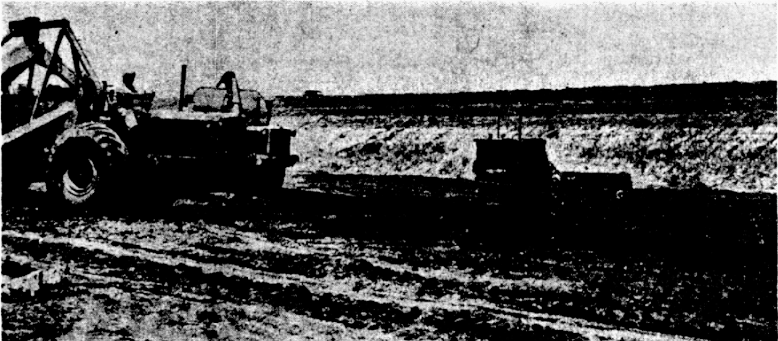
By mid-July the north abutment of the dam jutted prominently into Denton Creek lowlands, and earthen works for the spillway were almost complete. Giant sheepsfoot rollers exerting pressures of 540 pounds to the square inch were used to pack the content, and compaction samples were taken as every new layer of dirt was piled up on the abutments. Thanks to war-developed machinery, the thirty-six skilled men at the site could move more dirt than 5,000 men could have moved just twenty years earlier. Mosley’s men were moving about 9,000 yards a day, stopping only to service the equipment and rotate shifts. In mid-August the Grapevine Dam and Reservoir project was assigned the ACE Galveston District’s safety flag for working 509 days without a single accident. This was attributed to the resident engineer’s regularly scheduled safety meetings with the work crew.
Dallas and the Park Cities Get Their Permits
On August 9, the State Board of Water Engineers held a five-minute hearing in Austin on Dallas’s application to use water from Denton Creek which will be impounded by the dam. This was a formality in compliance with Texas law. Permit No. 1464 (Application No. 1572) dated August 19, 1948, was given to Dallas for the diversion of 85,000 acre-feet of water annually, and Permit No. 1465 (Application No. 1573), dated the same day to Dallas County Park Cities Water Control and Improvement District No. 2, was given for the diversion of 50,000 acre-feet of water annually, both permits for municipal, industrial, manufacturing, and recreational purposes.
Dallas was not alone in its concern about water supply. Grapevine had always drawn plenty of water from its two wells, but in early 1948 the City Council had begun planning for the time when the city would need more. Now that the dam and reservoir were being built and demand for real estate was increasing, a third well and underground storage tank would be needed. In early April, Mayor Deacon announced he would not run for re-election but presented his case for approval of the $100,000-revenue bond issue which would handle Grapevine’s water and sewage issues, now greatly influenced by the dam construction. He asserted that the city could not wait until 1952 when municipal water would become available from the new reservoir because the current water supply was running dangerously low. He also announced that the site of a mile-long sandy beach would be set aside three and one-half miles north of Grapevine as a public-use area when the lake was completed. Gordon Tate was elected the new mayor on April 3. Bids for the sewage disposal work were due by July 22, 1948.
On July 27, Grapevine City Council met in a special session to vote on three bids. It had authorized the firm of Freese & Nichols to review the bids and make recommendations for the three projects. Russ Mitchell (also working on the dam), Southwest Company of Fort Worth, and Municipal Tank Service of Arlington were awarded the contracts. Southwest was awarded $40,000 to build a lift station for the sewer system which would give service to residents south of the railroad. Mitchell, plus Wyche & Bruce Company, were to build the pump station for the new well. A $60,000 contract went to Municipal Tank Service for constructing a steel surface water reservoir with a capacity of 100,000 gallons. All work was completed by early August 1949, and the new well was producing 315 fifteen gallons per minute.
During September the ACE was surveying farmland at the reservoir site and conducting negotiations with owners. The federal government would eventually buy 21,000 acres on Denton Creek. In the meantime, the ACE prepared to ask for bids for the spillway construction and outlet works in the dam. Mosley was thirty-four days ahead of schedule due to the increase of his workforce to fifty men working in two shifts on nine-hour schedules. They already raised the embankment between the outlet works and spillway and were making the fill in the Denton Creek bottoms. At that pace, work on the first contract would be completed in October 1949.
Bids on the $2,000,000 second dam contract opened on December 7 at the ACE office in Galveston. This would be for concrete work on the spillway, installation of gates, and concrete for the outlet works, scheduled to start about mid-January 1949. The spillway was to be 500 feet long and thirty feet high. Outlet works consisted of an intake tour in the lake and a conduit through the base of the dam for the release of water. Russ Mitchell and the Wyche & Bruce Construction Company of Houston made the low winning bid and would have one 1,000 days to complete the job.
Growing Pains
Land negotiations were not the only issue confronting dam construction. Before the contract was awarded, company workers were already scouting Grapevine and vicinity for rooms, homes, and apartments. At the end of November Mayor Floyd Deacon stated that no living spaces were available in Grapevine for the one hundred men expected to work under the second contract. There were few if any vacancies in and around the city; new homes were being built but they were for sale rather than for rent. The mayor said that some workers would have to find housing in Dallas and Fort Worth. In October, he announced that the State Highway Department was stationing two patrolmen at Grapevine beginning November 1; the City Council asked for a sub-station due to city growth, increased traffic to the dam area, and possible overflow of traffic from the Greater Fort Worth International Airport.
In Part 5, we saw the procedure in which an unsatisfied land owner faced with eminent domain could appeal to a board of commissioners appointed by the federal court, and if the owner refused to accept the monetary decision by the board, he or she could ask for a trial in the federal court in which the judge and jury would decide the matter of compensation. In late November 1948, it was decided that these jury trials would be necessary because many landowners felt they were being poorly compensated for good farmland. US District Judge Thomas W. Davidson appointed Raymond P. Estes of Fort Worth and David Box and Floyd Deacon of Grapevine as commissioners. Landowners had ten days to appeal the commission’s awards and request jury trials.
First before the board was Grapevine resident Thomas G. Beckett. The government confiscated 489 of his 534.5 acres, including improved and unimproved land, in late December 1948. His hearing took place on March 4, 1949. Both Beckett and the government took exception to the $96,000 award, and a jury trial ensued in June, with varying estimates on the value of Beckett’s property. The government prevailed, with the jury awarding Beckett $82,000 in damages. Several decades later, Mary Virginia (Wall) Simmons, wife of displaced farmer Hugh Simmons, recalled how many landowners were paid poorly (sixty dollars per acre) for good farmland that was condemned.
On March 3, 1949, bids opened that included turfing of a downstream 5.8-acre section of embankment on the north end of the dam. The grass cover would protect the sandy downstream side of the embankment from spring rain erosion. The upstream side would be rip-rapped, meaning it would have human-placed rock intended to protect shoreline structures against water erosion. W. C. Richards of Athens was the low bidder for turfing but a contract was not let until later.
Also, outlet works for the dam were being installed, which included 32,000 cubic feet of concrete and thirty-inch steel tubes that would later siphon water from the lake to Dallas and the Park Cities. The base of the outlet works was in sandstone and shale that had to be sealed to prevent weathering. Within four hours after they were exposed, the walls of the cut were sprayed with asphalt, while the bottom was covered with a three-inch concrete blanket. This is what the three cities were paying for when they agreed to disburse $1,500,000 and $607,000, respectively, to obtain water from the lake when needed. A rainstorm that dropped 7.3 inches north and east of Dallas resulted in a four-day delay at all North Texas dam sites.
In May 1949, the House slashed the flood control allotment for the Grapevine project from the requested $4,000,000 to $2,976,000, but the Senate Appropriations Committee restored the original amount. This was good news for TIA general manager John Fouts, who stated that the project could keep going without any handicaps.
Another effect the dam was to have on the area was the condition of State Highway 114. In late June, Mayor Tate, former Mayor Deacon, and David Box appealed to Dallas to “do something” about widening the highway from that city to the new lake site. Backed up by the ACE, they warned that the narrow strip of highway winding across northwestern Dallas County would become the city’s busiest “pleasure” road when the dam was supposed to close in 1950. The one-hundred-foot right of way would not hold traffic between Dallas and the lake, they claimed, and should be widened to 220 feet. Grapevine leaders wanted the funds to be included in Dallas County’s proposed multi-million-dollar bond program, but the Dallas Morning News stated that the road structure itself belonged in Texas’s road-building program.
A minor controversy also erupted in July between Dallas and Fort Worth ironworkers unions as to which group should reinforce concrete at the dam. ACE engineers claimed that Fort Worth was closer; union rules gave jurisdiction to the local nearest the job and so that union began the work. Dallas workers objected. Evidence, based on an attorney who had a sideline business of computing distances for pigeon races, asserted that Dallas courthouse was actually closer to Grapevine – 19.10 miles compared to Fort Worth’s 19.28. The Dallas union, however, did not quibble over fractions, and so the two unions worked out a fifty-fifty deal on the project.
Twenty-eight promoters from the Lower Trinity, being a part of the larger Trinity River project, inspected the Grapevine dam site, among other Trinity watershed lakes, in mid-August 1949. Since canalization of the Trinity River to the Gulf was still under discussion, these men were most interested in developing sufficient water resources to take care of domestic needs for cities on the Upper Trinity with enough left to ensure canal navigation and irrigation of Lower Trinity valleys.
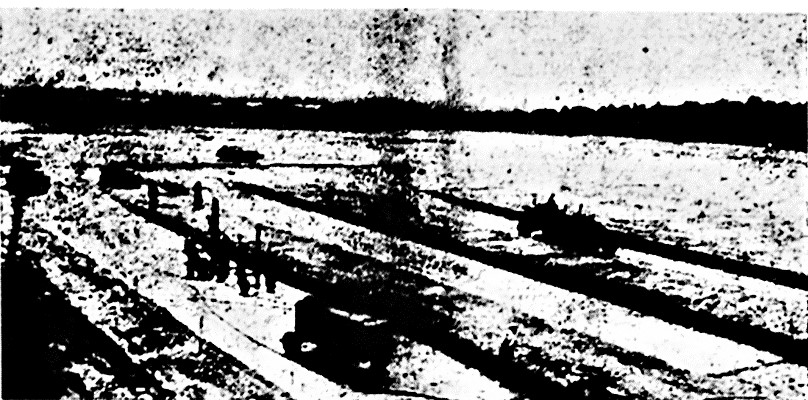
The Liberty Vindicator, 18 August 1949, p.1.
By late September 1949, the closing of the Grapevine Dam faced delay from August 1950 to July 1951 because a congressional committee trimmed the recommended $4,000,000 to $3,500,000, and contracts had to be rescheduled. The ACE surmised that the project could be completed by spring 1952 if Congress provided additional funding. It also congratulated Dallas and Fort Worth for getting their water programs underway in a timely manner.

Dallas Morning News, 19 August 1949.
In early October, the ACE had still not defined its “taking lines” for the now-government-owned land surrounding North Texas dam sites. Grapevine banker David Box observed that local buyers were “just waiting and watching.” Engineers had already taken over fourteen farms at Grapevine. Thomas Beckett, a Dallas electrical goods manufacturer, moved three houses out of Denton Creek Valley, but his $ 25,000 colonial home remained standing on a fifty-five-acre tract that would be partially surrounded by the new lake. The taking of most of T. R. Jones’s ranch near Grapevine left only twenty-six acres, on which his summer home stood, untouched. Jones had to move a five-room tenant house, barns, and chicken houses. Stanley D. Bowles sold 123 acres and moved his farm home three miles into Grapevine, and Frank P. Estill pulled stakes after selling his 334-acre place. Farmlands purchased included B. F. Mullins, fourteen acres; B. R. Mullins, 19; Mrs. Effie James, seven; Stanley D. Bowles,123; Howell P. Clark, 37.17; E. T. Simmons and J. N. Wood, one; Mrs. Emerson E. Corbin, 3.3; C. K. Simmons, 25.3; T. R. Jones, three tracts, 320.5, 8.1, and 13.2; Frank P. Estill, 334; T. G. Beckett, two tracts, 487.7 and 46.8, adding up to 1,439.9 acres.
Four more Grapevine farm tracts were acquired in November, the first since September 23. The landowners were Irene Dunn Howell, ten acres; F. W. Anderson, two tracts, 160.3 and 281.74; A. W. Day, 13.25, and Grace V. Thomas, 10.76 acres. This increased government landholdings at Grapevine to nineteen tracts and 1,921 acres.
We feel like the people of Grapevine are entitled to some water rights because they are having to go fifty miles from here to replace their farms that will be inundated.
Grapevine Mayor Gordon Tate
With a population of almost 2,000 and growing, by November 1949 Grapevine was mushrooming and trying desperately to keep ahead of its growth by providing adequate water and sewer facilities. As then-mayor Floyd Deacon hoped the previous April, $100,000 was raised by bond purchases without hiking taxes or water and sewer bills. The city also wanted the right to use water from the reservoir but did not have the $25,000 to pay the government for the future use of 1,250 acre-feet of water. They would have to borrow some of it. A frustrated Mayor Gordon Tate likely expressed the community’s sentiments when he said that “We feel like the people of Grapevine are entitled to some water rights because they are having to go fifty miles from here to replace their farms that will be inundated.”
The dam was about fifty percent complete by mid-December 1949. Two more land purchases were made for water areas: 260 acres from Mrs. F. P. Wiegers, and thirty-two acres from L. G. Bevans. The government then owned twenty-one Grapevine tracts, totaling 2,113 acres. The dam had become a $16,564,000 project, with expenditures for 1949 totaling $1,655,130.
Henry Ellison Saunders was born in the early-day settlement of Dunnville (now Grapevine) on December 15, 1868. He had grown up along Denton Creek – his “swimmin’ hole” – and was affectionately known in the community as “Uncle Bud,” and was held in high esteem for providing financial aid guidance to young men in the community. Confined at home by ill health at the start of the dam construction and unable to attend the ceremony, he hoped to obtain a clod of soil from the ground-breaking and to recover sufficiently to “go for a boat ride” on the new lake after its completion. Unfortunately, “Uncle Bud” died on April 8, 1948.
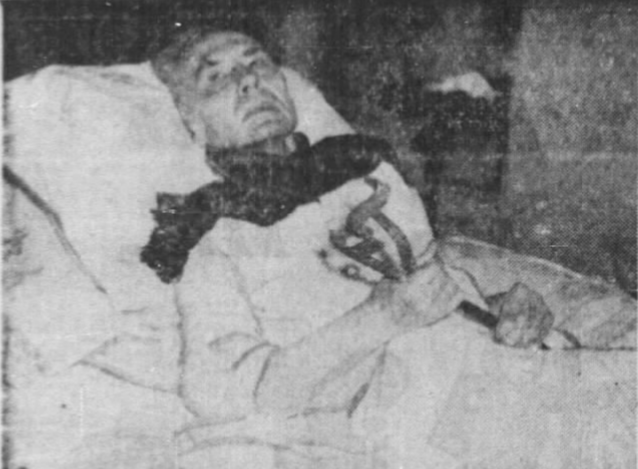
“Uncle Bud” Saunders did not live long enough to see the dam and reservoir become a reality, but his community, including many with mixed feelings, watched the project to its completion. In our final blog post on the origin and history of the lake, the dam gates close, and families who once owned and/or worked on lands along Denton Creek reflect on the effects of the Grapevine Dam and Reservoir project on their small but growing city.


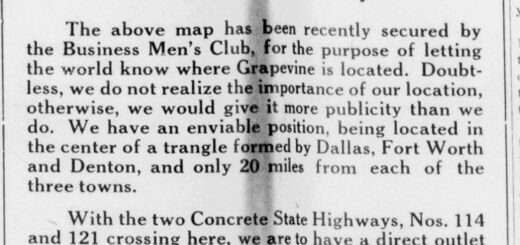
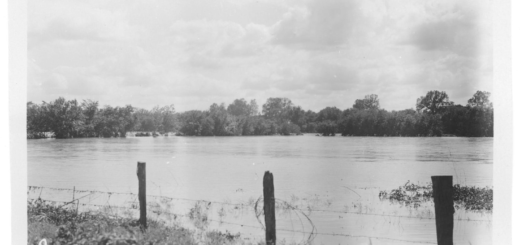

Recent Comments